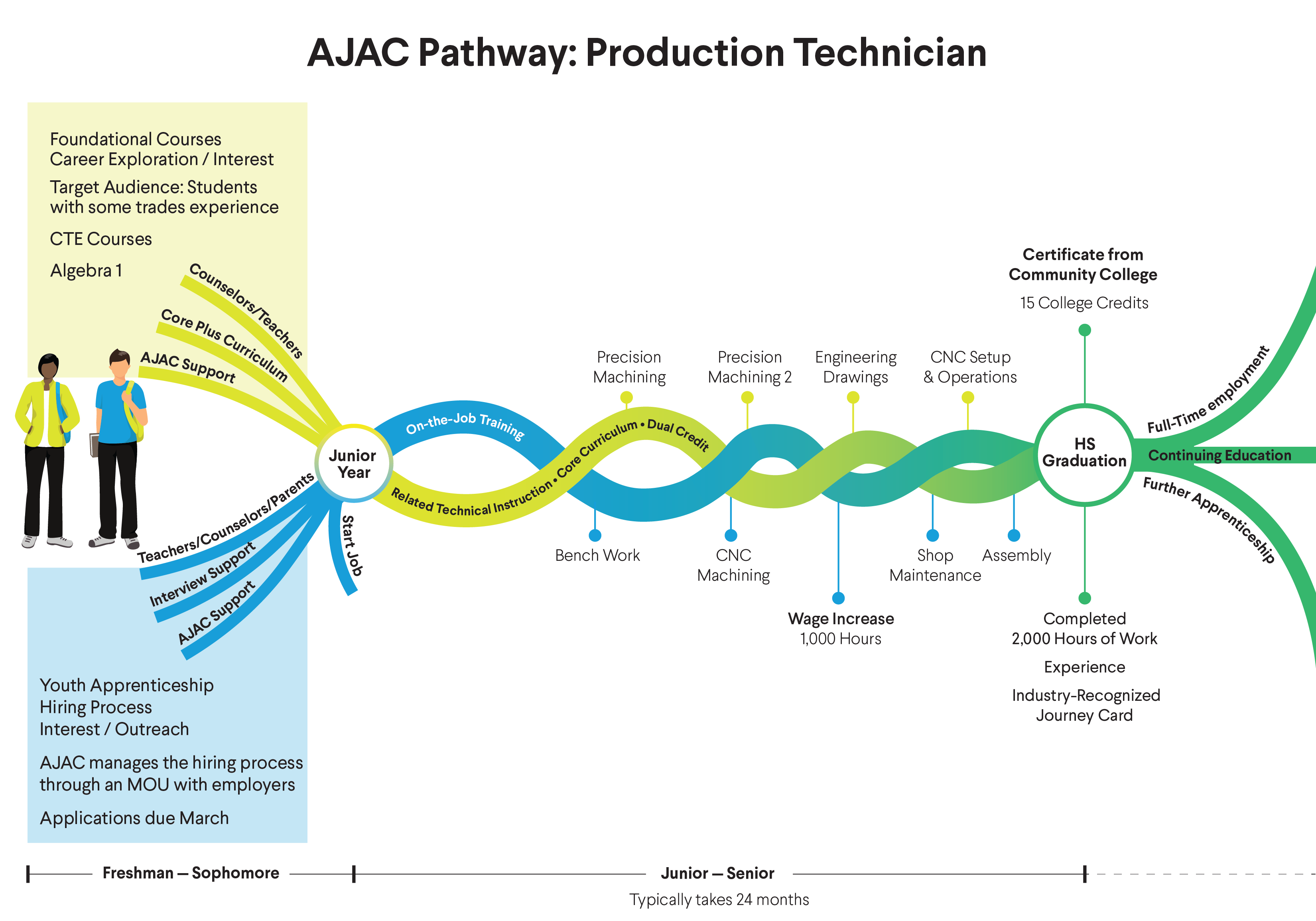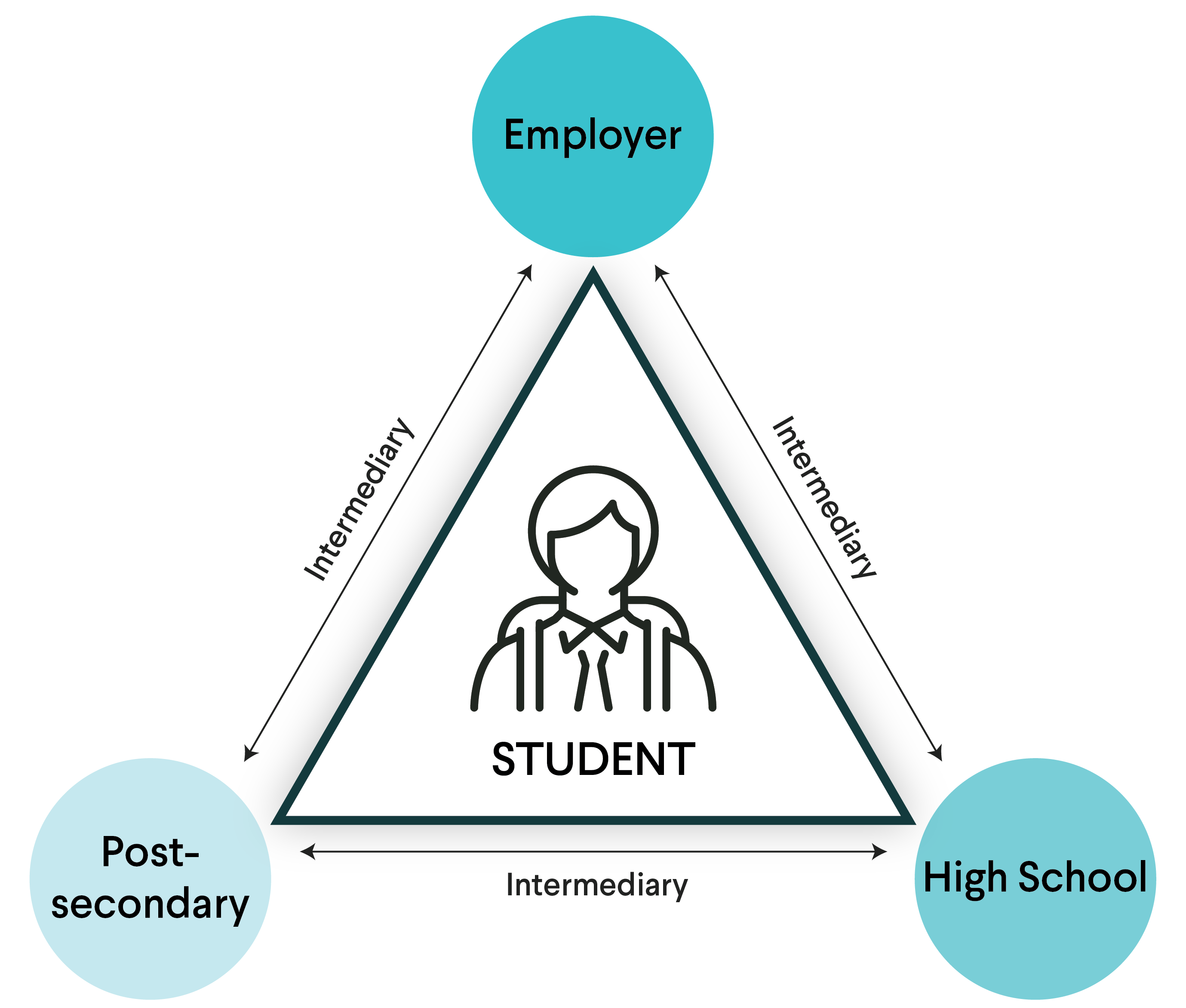
Youth Apprenticeship
May 30, 2020
At A Glance
Youth apprenticeships are paid work-based learning programs for young people ages 16-24. They feature a combination of on-the-job training and classroom instruction.
What Is Youth Apprenticeship?
Youth apprenticeships are apprenticeship programs that are specifically designed for young people between the ages of 16 and 24—whether in school or out of school.
Apprenticeship is a proven workforce training model that combines paid on-the-job training and formal classroom or online instruction to help a worker master the knowledge, skills, and competencies needed for career success. Registered Apprenticeship (RA) programs feature the basic apprenticeship elements of paid training and educational instruction, but they are industry-vetted and meet U.S. Department of Labor (DOL) standards for rigor and quality.
Youth apprenticeships feature the same basic elements as apprenticeships, including paid work-based learning activities and classroom instruction related to the apprentice’s workplace responsibilities, but they generally require lower daily time commitments to accommodate the schedules of high school students. They provide opportunities for young people who are preparing for postsecondary work and learning journeys to gain experience and build skills in real work environments. And they give businesses a chance to inspire and develop a new generation of talent.
Hear from youth apprentices themselves about why they choose to apprentice!
Youth Apprenticeship Today
 |
Source: Registered Apprenticeship Partners Information Database System, U.S. Department of Labor. |
A recent Jobs for the Future (JFF) analysis of federal apprenticeship data showed a 113% increase in the number of 16-to-24-year-olds joining a Registered Apprenticeship program from 2010 to 2020. (See chart above.) More than 40,000 young people joined an RA program in 2020.
While the analysis only covered Registered Apprenticeship programs with 16-to-24-year-old participants, not specifically youth apprenticeship programs (those explicitly designed for young people), it paints an important picture of the state of apprenticeship for young people.
There are several bright spots: The number of young people between ages 16 and 24 participating in apprenticeship grew dramatically from 2010 to 2020 and at a much higher rate than overall youth employment. Moreover, the average exit wage of $30 per hour for young people completing apprenticeships is much higher than the median wages among all young people, attesting to the power of work-based learning to move people into well-paid jobs. And while STEM apprenticeships still represent a small proportion of apprenticeship programs, participation in those programs did show substantial growth over the decade, reflecting an emerging national focus on building alternative youth pathways into careers in science, technology, engineering, and math.
Despite these gains, apprenticeship participation rates and outcomes for people of color and women of all backgrounds lag behind those of their white and male apprentices. The percentages of women and Black apprentices did not budge significantly between 2010 and 2020, despite the dramatic growth in overall participation. And the occupational segregation seen most dramatically when comparing male and female apprentices (and, to a lesser degree, when comparing Black apprentices to white apprentices) has resulted in significant differences in earnings and advancement opportunities.
To support programs in implementing practices that promote diversity, equity, inclusion, and accessibility (DEIA) in apprenticeship, JFF has created a program design framework for employers and Registered Apprenticeship sponsors. This program has field-informed program design elements and considerations for building systems, processes, partnerships, and practices that can drive DEIA in their programs, providing access and support to youth apprentices of all backgrounds.
What Youth Apprenticeship Looks Like

This graphical depiction of the timeline of a production technician apprenticeship managed by AJAC, a Kent, Washington-based provider of advanced manufacturing apprenticeships, offers an example of the typical journey students in CRYA programs may experience and the foundations and supports they’d receive along the way.
The Charleston Regional Youth Apprenticeships (CRYA) initiative in South Carolina is a two-year program that Trident Technical College launched in 2014 after being approached by a local employer interested in setting up a youth apprenticeship in industrial mechanics. Trident worked with the employer to bring other employers together to form a sector partnership to develop the program and ensure that it would have sufficient support to stay up and running over time. This ambitious group of employers pushed for a program start within four months and hired 13 initial apprentices. CRYA’s work-based learning programs meet Registered Apprenticeship standards. As of 2021, it had grown to 18 pathways in nine industry sectors with 180 registered companies. Through 2020, it had had 351 youth apprentices, with approximately 70 new hires for the 2021-22 school year as of August 2021. There were 119 apprentices for the 2019-20 school year.
Rising juniors, rising seniors, and graduating seniors are eligible to participate in CRYA programs. They must complete a rigorous application process in the year preceding the apprenticeship, and they must be hired by one of the participating employers, who make all hiring decisions. Students commit to two years in the program, but the timetable is flexible: Those who readily demonstrate competency in their coursework and on-the-job activities can complete the program sooner, and others may take additional time if they need it.
Getting Started With an In-School Youth Apprenticeship
FIND PARTNERSYouth apprenticeships are surrounded by an ecosystem that includes employers, local school districts, high schools, providers of postsecondary education (usually community colleges), and one or more intermediaries—organizations that coordinate activities and act as liaisons for all partners. |

- High schools create the enabling environment for students to participate in youth apprenticeships. They and students’ guardians must give formal permission for students to participate in any postsecondary instruction or on-the-job learning during regular school hours. They play a role in providing coursework as part of related technical instruction, and they help recruit and prepare students for their apprenticeship programs in addition to ensuring that students will meet graduation requirements.
- Postsecondary institutions deliver related instruction that complements what apprentices learn on the job. They can customize coursework to meet the needs of specific industries while ensuring that subject matter is also relevant to the broader labor market.
- Employers work with the education partners to identify the skills they need apprentices to learn, build training plans, and deliver the on-the-job training. Employers anchor youth apprenticeship programs because they hire the apprentices and offer them opportunities to earn money while they learn valuable skills in real workplaces like hospitals, factory floors, or labs. They’re also responsible for helping to define, deliver, and document the learning that takes place.
- Intermediaries are essential to the success of apprenticeships. They coordinate the activities of key partners to ensure that both employers and apprentices get the support they need, and they must be prepared to respond to requests for assistance from multiple constituencies. They can be part of one or multiple organizations, including chambers of commerce, community colleges, nonprofits, and school districts.
ASSESS YOUR READINESS |
|
|
Employers, community colleges, and other local, state, or regional entities can use JFF’s Self-Assessment and Planning Tool for Youth Apprenticeship Programs to gauge their capacity to implement and manage a high-quality youth apprenticeship program. This tool focuses on critical foundational factors, including the strength of an organization’s leadership, partnership opportunities, and program supports. |
|
GET SUPPORT |
|
|
JFF can offer apprenticeship providers and practitioners one-on-one coaching and other support services on topics like these:
|
|
Resources for Youth Apprenticeship

Further Your Youth Apprenticeship Program with an Online Communications Strategy
This guide will help your youth apprenticeship program develop an online communications strategy to reach your program goals. You will learn how to identify your key audiences, messages, and channels, and how to use tools…

Adaptability in Youth Apprenticeship: Meeting the Needs of Students and Employers
Adaptable apprenticeships collaboratively design the program's learning component so that it is recognized and valued across an industry or sector.

Self-Assessment and Planning Tool for Youth Apprenticeship Programs
This self-assessment and planning tool assists local, state, or regional lead entities and their partners in gauging their current capacity to establish a high-quality system for high school-based youth apprenticeships. This self-assessment and planning tool…

Young Adults in Registered Apprenticeship
Young adults are invaluable members of our labor market and bring critical talent, capacity, skill, and innovation to the workforce. However, many young adults—especially those ages 16-24 from low-income communities—face significantbarriers in the labor market.…

5 Reasons You Should Think about Apprenticeship for Your Child
Apprenticeship can offer an alternative to college and open doors to many career opportunities.
